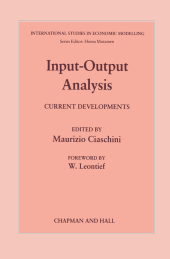 Neuerscheinungen 2011Stand: 2020-01-07 |
Schnellsuche
ISBN/Stichwort/Autor
|
Herderstraße 10
10625 Berlin
Tel.: 030 315 714 16
Fax 030 315 714 14
info@buchspektrum.de |

M. Giaschini
Input-Output Analysis
Current Developments
Herausgegeben von Giaschini, M.
1988. 2011. xvi, 414 S. 235 mm
Verlag/Jahr: SPRINGER NETHERLANDS; SPRINGER 2011
ISBN: 9401076766 (9401076766)
Neue ISBN: 978-9401076760 (9789401076760)
Preis und Lieferzeit: Bitte klicken
The twenty-two chapters included in this book were written by as many scholars working independently of each other in different countries. They present, nevertheless, a well integrated picture of systematic advance in the field of input-output analysis on the broad front, stretching from formal mathematical modelling, through construction of large, specialized databases to detailed empirical inquiry and concrete examples of practical applications. While reflecting a great variety of individual interests and working styles, these contributions taken together provide evidence of what might appear to be co ordinated efforts. This coherence has not been brought about by the central guidance so typical of modern large-scale research. It simply reflects the internal discipline and cohesiveness of a particular methodological approach. In input-output analysis, empirical inquiry and theoretical model building have to be carried out hand-in-hand. If the aim of the investigation is to provide concrete, detailed explanation of observed reality, building an elaborate mathematical model makes little sense without an appropriate database. The language and the terminology used in the construction of that database must, however, be exactly the same as that employed in the formulation of the theoretical model. The same specifications and definitions must, of course, be adhered to - after the theoretical computations have been completed - in the interpretation of the numerical results.
1 Input-output analysis: an introduction.- One Problem definition: data sources and modelling outcomes.- 2 Homogeneity of price development within commodity groups and by demand components.- 3 Important input coefficients in market transaction tables and production flow tables.- 4 Government production in ESA and SNA tables.- 5 The use of a social accounting matrix for comparative static equilibrium modelling.- 6 Positive solutions for the Leontief dynamic input-output model.- 7 Demand versus supply determinants of disproportional growth in open economies.- 8 Analysing structural change in the economy.- 9 Turnpike stability of decomposable systems and the efficiency of growth planning.- Two Topics in economics: inflation, productivity and demands.- 10 Cumulative inflation and dynamic input-output modelling.- 11 Productivity growth and technical change.- 12 Intra-industry trade in the manufacturing industries of Japan.- 13 Energy intensities, input-output analysis and economic development.- 14 How to observe a Leontief paradox - and how not to.- 15 Investment coefficient matrix in dynamic input-output models: an analysis and prognosis.- 16 Consumption turnpike in a non-linear model of the input-output type.- Three National and regional level: the macroeconomic, multisectorial and multiregional framework.- 17 The use of impact tables for policy applications of input-output models.- 18 Growth and changes in the structure of the Finnish economy in the 1960s and 1970s.- 19 Economic growth and structural change in the Soviet economy, 1959-72.- 20 Multiplier impacts of fishing activities in New England and Nova Scotia.- 21 A model for assessing the growth opportunities of EEC countries when interdependence is not ruled out.- 22 The INFORUM-ERI international system of macroeconomic input-output models.
A reference for economic researchers and for those concerned in governments and international organizations with the major issues of economics, trade and development. - Reference and Research Book News; ...the twenty-two contributions are of the highest class and range in content from the theoretical to the empirical. - Regional Studies


